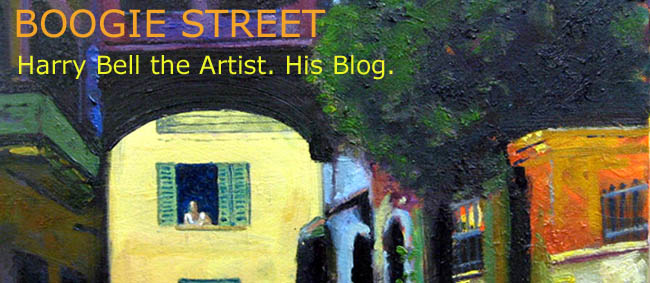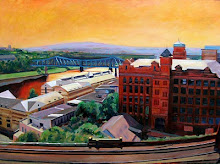I'm off to Prague for a week. Patsy123 bought me this short break for my birthday and we fly out of Newcastle later today. While there, we'll be linking up with Buddy K and Susie Sue and generally having fun.
Please try to have some fun yourselves.
Thursday, 13 March 2008
Friday, 7 March 2008
Back on the Grand Canal

Vaporetto 3 (work in progress)
I returned to this other vaporetto picture yesterday determined to move it along. I've knocked in rather roughly a new background which I think will work well. At the moment it needs pushing further back and the columns, balconies and windows need development, but it looks OK today and I'm not disappointed with yesterday's work.
I'd have preferred to work on it again today, but there's still a tackiness to the paint, so I'll have to be patient and turn my attentions elsewhere.
Labels:
oil paint,
painting,
vaporetto,
Venice,
work in progress
Thursday, 6 March 2008
Raimonds Staprans
I’ve been interested in the work of Raimonds Staprans for some time now. He’s a fascinating man: a Latvian-American, he’s celebrated in Latvia as a playwright, in the USA as a painter.
Starting with Diebenkorn, I’ve gradually been exploring a small selection of Bay Area painters. After Diebenkorn came Wayne Thiebaud, then Elmer Bischoff. I was able to pick up books on all three without too much effort, but publications on Staprans eluded me. Until now. Last week I took delivery from Amazon of Raimonds Staprans: Art of Tranquility and Turbulence by Paul Karlstrom.
Karlstrom is clearly something of an expert on Staprans. In the Smithsonian Archive of American Art is an interview Staprans gave to Karlstrom in 1997. It’s a fascinating insight into Staprans’s thoughts about art, the development of his career and how he feels it was held up by staying with one gallery. In particular, his comments about the work of Diebenkorn and Thiebaud are illuminating, even if, at times I think he may be wrong in his conclusions.
I read this interview a couple of years ago, but reading the interview without the benefit of some printed images as illustrations occasionally made for opaque understanding. So it was rewarding in a number of ways to find that a book had finally been published about Staprans and his work.
The pictures in it form something of a retrospective, not surprisingly because it was conceived in connection with a retrospective exhibition of Staprans’s work at the Pasadena Museum of California Art in January 2006 (which then transferred to the Latvian National Museum in Riga).
The paintings begin in the early 196os in a very West Coast abstract way, with hints of de Stael in the blocks of thick colour, but these are gradually replaced by abstract landscapes composed of large areas of broad smooth colour.
In the early 70s, Staprans turned to the female figure for subject matter and there are a number of quite disturbing female nudes, their heads almost non-existent, their genitalia aggressively displayed and the pictures suffused overall with blood red. Staprans has some firmly held views on sexuality which he talks about in the Smithsonian interview and which are the main theme of one of his most famous Latvian plays, The Freezing (excerpted in the book).
Of greatest interest to me are the later landscapes, and some of the still lifes of cans of paint, tables and fruit. The landscapes are quite striking. On first viewing they appear to be severe landscapes with all human life and any incidental detail removed. There’s an eerie silence to them and they’re all bathed in the fierce glare of Californian sunlight.. Staprans says:
Yet Staprans maintains that all of them – still lifes and landscapes - are constructs, not taken directly from the real world or real locations at all. He’s working in the field of what he calls abstract realism. He builds his pictures “from the ground up,” making compositional sketches and working with a strict geometry, he attempts to create order out of what he sees as the chaos of the natural world.
Starting with Diebenkorn, I’ve gradually been exploring a small selection of Bay Area painters. After Diebenkorn came Wayne Thiebaud, then Elmer Bischoff. I was able to pick up books on all three without too much effort, but publications on Staprans eluded me. Until now. Last week I took delivery from Amazon of Raimonds Staprans: Art of Tranquility and Turbulence by Paul Karlstrom.
Karlstrom is clearly something of an expert on Staprans. In the Smithsonian Archive of American Art is an interview Staprans gave to Karlstrom in 1997. It’s a fascinating insight into Staprans’s thoughts about art, the development of his career and how he feels it was held up by staying with one gallery. In particular, his comments about the work of Diebenkorn and Thiebaud are illuminating, even if, at times I think he may be wrong in his conclusions.
I read this interview a couple of years ago, but reading the interview without the benefit of some printed images as illustrations occasionally made for opaque understanding. So it was rewarding in a number of ways to find that a book had finally been published about Staprans and his work.
The pictures in it form something of a retrospective, not surprisingly because it was conceived in connection with a retrospective exhibition of Staprans’s work at the Pasadena Museum of California Art in January 2006 (which then transferred to the Latvian National Museum in Riga).
The paintings begin in the early 196os in a very West Coast abstract way, with hints of de Stael in the blocks of thick colour, but these are gradually replaced by abstract landscapes composed of large areas of broad smooth colour.
In the early 70s, Staprans turned to the female figure for subject matter and there are a number of quite disturbing female nudes, their heads almost non-existent, their genitalia aggressively displayed and the pictures suffused overall with blood red. Staprans has some firmly held views on sexuality which he talks about in the Smithsonian interview and which are the main theme of one of his most famous Latvian plays, The Freezing (excerpted in the book).
Of greatest interest to me are the later landscapes, and some of the still lifes of cans of paint, tables and fruit. The landscapes are quite striking. On first viewing they appear to be severe landscapes with all human life and any incidental detail removed. There’s an eerie silence to them and they’re all bathed in the fierce glare of Californian sunlight.. Staprans says:
As one deplanes in San Francisco, one is blinded by the unbelievable intensity of the sun. And the light is so white and so aggressively energizing, that one automatically gropes for his sunglasses. And so it goes for eight months each year – nothing but blue skies and that blinding light. It is impossible to ignore it.
Yet Staprans maintains that all of them – still lifes and landscapes - are constructs, not taken directly from the real world or real locations at all. He’s working in the field of what he calls abstract realism. He builds his pictures “from the ground up,” making compositional sketches and working with a strict geometry, he attempts to create order out of what he sees as the chaos of the natural world.
Labels:
abstract,
Bischoff,
de Stael,
Diebenkorn,
landscape,
nudes,
painters,
painting,
Raimonds Staprans,
Smithsonian,
Thiebaud
Wednesday, 5 March 2008
More about Chadbourn
My SiteMeter continues to show people coming here to read what I said about Alfred Chadbourn. For those who want to read a little more, I recommend an article by the late Charles Sovek, in which he expands on Chadbourn's use of three values. Sovek himself was an accomplished painter whose style closely resembles that of Chadbourn and his site, now maintained by his family, still holds many of his pictures and, more especially, his other interesting articles from The Artist's Magazine.
Labels:
Alfred Chadbourn,
Charles Sovek,
oil paint,
painters,
painting
Tuesday, 4 March 2008
Old Town Hall

Old Town Hall (oil on canvas, 12 x 14 ins) SOLD
This is how it looked when I handed it in yesterday. I'd come to the conclusion that there were too many colours fighting one another, so I dispensed with the purple sky and opted instead for one made from ultramarine with a little cadmium orange in it (both colours used in the rest of the painting).
I also managed to get a little work done on one of the Vaporetto pictures. These will represent my main occupation in the next few weeks, if I'm to have sufficient work ready for the show opening in April.

Caught in the Spotlight (work in progress)
Labels:
oil paint,
Old Town Hall,
painting,
painting progress,
vaporetto
Subscribe to:
Comments (Atom)











